Storming "Caucasian Ishmael"
At this time, Commander-in-Chief Ivan Vasilyevich Gudovich (1741 - 1820) was appointed commander-in-chief of the Kuban and Caucasian corps, a Caucasian fortified line. It was an experienced military leader. Gudovich came from a kind of Polish gentry who switched to the Russian service in the 17 century. Thanks to a wealthy father - the Little Russian landowner, he received a multifaceted education, he studied in universities of Konigsberg, Halle, Leipzig. He entered the military service late - in 19 he became an ensign of the engineering corps. An officer who had an excellent education after a year was taken to his lodge by the most powerful grandee, Count Peter Shuvalov. Then Lieutenant Colonel Gudovich becomes the adjutant of Field Marshal Andrei Shuvalov. Such rapid growth is explained simply - his brother Andrei Gudovich was the adjutant general of Emperor Peter III. After the palace coup, when Catherine II seized power, Gudovich fell under a three-week arrest, but then he was sent to command the Astrakhan Infantry Regiment. In 1763, he was promoted to colonel. The regiment was sent to Poland, where he kept order - the election of the king was held, in 1765 he returned to Russia. Gudovich successfully fought in the Russian-Turkish war of 1768 — 1774, he distinguished himself in the battle of Hotin (11.7.1769), Larg (7.07.1770), Cagul battles (21.07.1770) and a number of other battles. He was promoted to brigadier. After the end of the war, he became division commander in Ukraine in the Ochakov area and on the Southern Bug River, then in Kherson. In 1785, he was appointed Governor-General of Ryazan and Tambov and at the same time inspector of cavalry and infantry (infantry), directly submitting to the all-powerful favorite of Empress G. Potyomkin. When the new war with Turkey began - in 1887, he asked for the front and was appointed corps commander. Under his command, Russian troops took Khadzhibey (14.9.1789) and the fortress of Kiliya (18.10.1790).
Having been appointed to the North Caucasus, Gudovich had orders from Potemkin to strengthen the Caucasian line. This fortified line was of great importance for the defense of the South of Russia. The port tried to restore the North Caucasian nationalities against Russia in order to maintain its position in the region. For more than two centuries this frontier has been a place of constant skirmishes and wars. In 1783, the Caucasian line was divided into two parts: Mozdok - on the left bank of the Terek (3 fortress and 9 Cossack villages), on the Kuban steppe (9 field fortresses), and Kuban - on the right bank of the Kuban river (8 fortresses and 19 fortifications). After the annexation of the Crimea to Russia, it became obvious that it was necessary to strengthen the defense of the Kuban. Turkey could strike from the fortresses of the Black Sea coast of the Caucasus and raise the Highlanders for an auxiliary strike. Grigory Potemkin was instructed to build fortifications along the village of Ekaterinodar - the Malka River - the Laba River (it flowed into the Kuban). Two outposts and three Cossack villages were built on the river Malka opposite the Big Kabarda. Between Malka and Kuban built the fortress of Constantinogorsk and 5 fortifications. On the right bank of the Kuban built three fortresses, fortifications 9 and one village. These works were carried out between 1783 and 1791 years.
Anapa Preparation for the hike
The headquarters of the Russian troops in the Caucasus at that time was located in a small fortress in the middle of the Caucasian line - Georgievsk. Gudovich immediately inspected the forces and fortifications entrusted to him. And I realized that the main danger comes from Anapa. It was a powerful fortress with a large garrison, which had the opportunity to receive reinforcements and armament by the sea, moreover it was located in a dangerous vicinity of the Kerch Strait. Through Anapa, the Turks could incite the mountain peoples against Russia. Gudovich decided to uproot this “thorn” at the Russian border, since there was a war and there were relevant instructions from Potemkin.
The Turkish fortress was founded on the site of the ancient Sindi settlement - Sindi harbor (Sindiki), which appeared before our era. After joining the Kingdom of the Bosporus Gorgippia was called, from 13 centuries of our era - the colony of the Genoese Mapa. It belonged to the Turks since 1475, in the 1781 — 1782 years powerful fortifications were built there. In Istanbul, they understood the importance of the position of Anapa and did not spare significant money for the construction of strong fortifications under the leadership of French engineers. Under the Turks, Anapa became one of the largest centers of slave trade in the Black Sea basin. It should be noted that the slave trade was one of the most important and profitable sectors of the economy of the Ottoman Empire. Highlanders, especially the Adyg feudal lords, were also focused on this activity. After two Russian expeditions to Anapa failed in 1787 and 1790, the Turks became convinced of the inaccessibility of the stronghold. Anapa, along with Ishmael, was considered a strategic fortress.
Gudovich spent two months preparing the march to Anapa. Field artillery was brought from various fortresses and fortifications, arbs were prepared (wagons), and pack animals were collected. For the collection of troops, two collection points were identified: to the Kuban border post, Temizhbek retaliated parts of the Caucasian Corps; to the Yeisk fortification on the Azov coast, troops of the Kuban Corps commanded by Major General Zagryazhsky (from Voronezh) marched. At the same time, they left enough forces on the Caucasian line to stop the possible raid of the Highlanders.
May 4 Temizhbek stood 11 infantry battalions, 24 squadron of cavalry and 20 guns. The infantry of the expedition consisted of incomplete (in them were about 1 thousand people) Tiflis, Kazan, Voronezh and Vladimir regiments. Three battalions of well-trained and battle-hardened gunmen were separated from the Caucasian Chasseurs Corps. The cavalry consisted of four squadrons of Rostov, three - Narva, one - Kargopol carabinieri regiments; eight squadrons were in the Astrakhan and Taganrog dragoon regiments. Cavalry units were also incomplete. Hopersky, Volgsky, Don Koshkin and Lukovkina regiments also went on the march. Plus, two hundred Grebensky and a half hundred Terek Cossacks.
On May 10, the forces of the Kuban Corps were concentrated in the Yeisk fortification - the Nizhny Novgorod and Ladoga Musketeers, the Vladimir and Nizhny Novgorod Dragoon, and two Don Cossack regiments, with 16 guns. In total, up to 15 thousand people took part in the campaign, taking into account the protection of rear communications, which remained in small fortifications along the way of the detachment.
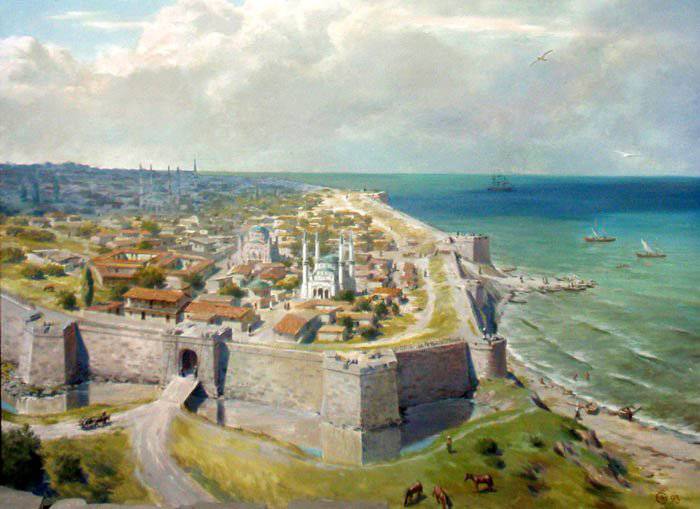
The painting "Turkish fortress Anapa." Artist Yuri Kovalchuk.
Hike and siege of the fortress
The morale of the expedition was high, the soldiers and officers were not embarrassed by the failure of two previous campaigns. Everyone heard the news of the Russian victories on the Danube, including the brilliant victory in Izmail. Soldiers and officers wanted to glorify Russian weapon and on the Caucasian front. On May 22, units of the Caucasian Corps approached the Talyzin crossing, two days later the Kuban Corps joined them. Immediately began to build a pontoon ferry and field bridgehead reinforcement in case of enemy attack. On the way to the Talyzin crossing, Gudovich left small garrisons in fortified posts and redoubts to secure the rear and communications. So, on the way to Yeisk fortification, six earthen redoubts were built.
29 May troops without any problems crossed to the other side of the Kuban. True, the mountaineers tried to destroy the crossing, lowering the logs of large trees along the river, but the diversion failed. In one transition from Anapa, a detachment from the Tavrichesky Corps (located in the Crimea) under the command of Major General Shitz - 3 battalion, 10 squadrons, 3 hundreds of Cossacks with 14 guns joined. They brought with them 90 assault ladders.
The success of the expedition could be largely due to the attitude of the Highlanders to the Russian corps. Highlanders could dramatically complicate a combat operation. Therefore, Gudovich showed the talent of a diplomat, informing the local feudal lords that the Russians were planning to fight the Turks, not the highlanders. He ordered the release of prisoners of Circassians who attacked carts, foragers, not to offend the locals, not to sow the crops.
Turkish intelligence monitored the movement of the Russian corps, but did not dare to give battle to the fortress of Anapa Pasha. Only at the very fortress, a detachment of several thousand Turks and Highlanders occupied the commanding heights along the Narpsuho River and tried to stop the Russian avant-garde. But the Russian forward units under the command of brigadier Polikarpov forced the river along the way and resolutely went on the attack, Gudovich supported the vanguard with several squadrons of dragoons. The Turks and Circassians did not accept the battle and almost immediately fled. 10 June Russian units approached Anapa, the siege and preparation for the assault began.
Turks significantly strengthened the fortress to the arrival of Russian troops. They updated and deepened the moat, a powerful rampart resting against the ends in the sea was reinforced with a palisade. The garrison totaled up to 25 thousand people (10 thousand Turkish infantry and 15 thousand highlanders and Crimean Tatars), with 95 guns and mortars. There were several ships on the raid from which additional guns could be removed. In addition, the garrison could be strengthened by sending reinforcements by sea. There was no hope of forcing the Turks to surrender - ammunition and food were easily delivered by sea. Russia has not yet been powerful fleetwho could block Anapa from the sea. The fortress was commanded by the experienced Mustafa Pasha, his assistant was Batal Bey (at one time he tried to break through the Caucasian line and raise the North Caucasian nationalities against Russia). In Anapa, there was also a military, religious and political leader of the Caucasian highlanders, the Chechen Sheikh Mansur. He was a "prophet", the forerunner of the ideas of Muridism - he opposed the slave trade, feudal lords, blood feud, believing that mountain customs should be replaced by Muslim Sharia law. He raised the highlanders to the “holy war” against Russia, his ideas were popular not only among Chechens, but also Circassians and Dagestanis. He had a number of private successes, but was eventually defeated and took refuge in Anapa with the rest of his strength.
Gudovich cut off the fortress from the mountains so that it would not come to help - during the siege, the enemy tried several times to get to Anapa, but was repulsed. The left flank cut the road to the fortress of Sudzhuk-Kale (in place of modern Novorossiysk). The main forces stood on the left bank of the Bugru River, the Shitz squad on the right bank. On the night of June 13 put the first siege battery. In the morning, the Turks opened up strong firing and sent a 1,5 thousand unit to destroy the battery. Two hundred huntsmen under the command of Zagryazky, who were guarding the battery, met the enemy with a friendly salvo, and then hit the bayonets. The Turkish detachment was overturned and fled in panic, the Russian huntsmen chased the enemy to the gates of the fortress.
By 18 June, several more siege batteries were erected. That day they began bombing the fortress. The Turks initially responded actively, they had an advantage in the number and power of the guns. An artillery duel ensued, in which the Russian artillerymen won. Soon the fire of the Turkish artillery began to subside, an enormous fire lit up at night Anapa - the pasha's palace, the garrison's food store and other buildings were burning. The next day, the Turkish batteries almost did not respond, suppressed by the fire of Russian artillerymen. The Turkish command made a big mistake, having in hands considerable forces, it refused attacks. The garrison lost heart. Gudovich offered honorable capitulation, with the exit from Anapa of all Turkish troops. Mustafa Pasha was ready to capitulate, but Sheikh Mansur opposed. He turned out to be a more influential figure, and the Turks refused to surrender the fortress.
Assault
Gudovich made a very risky decision - to take Anapa by storm. He decided to storm a powerful fortress with 25 thousand garrison having a total of 12 thousand people. But there was no other way out: strong reinforcements could arrive from the sea, this could make a difference in favor of the Turks; in the near rear there were up to 8 thousands of Circassians and Turks, who constantly harassed Russian posts, hindered the search for food and feed for horses. The Russian command could not organize a proper siege, as there were not enough large-caliber artillery and engineers. A letter arrived about the emergence of a powerful Turkish fleet near the Dniester, which meant that enemy ships could appear at any time with reinforcements and instruments for a fortress.
Gudovich decided to strike the main blow against the southeastern part of the fortress wall. The 5 shock columns were formed: the four main columns of 500 people each had to strike in the southern part of the fortress, general command was carried out by major generals Bulgakov and Depreradovich. Behind them were reserves that were supposed to strengthen the columns in the event of the failure of the first assault or to be used to develop success. There was a general reserve under the command of brigadier Polikarpov, he had to react to a change in the situation in any of the directions. The fifth assault convoy from 1300, under the command of Colonel Apraksin, was to make a diversion to break into the city along the coast. In addition, given the danger of striking from the rear, an 4 thousand detachment was commanded under the command of Zagryazhsky, who was supposed to block a possible enemy strike from the outside. A marching wagenburg (mobile field reinforcement), guarded by three hundred riflemen with 7 guns. As a result, no more than 6,4 thousand people, from 12 thousand Russian troops, took part in the assault.
On the night of June 21-22, the assault columns and all units took up their positions. Moved secretly, trying not to frighten the enemy. At midnight, the batteries began bombing the fortress. Under the rumble of guns and explosions, attack aircraft approached even closer to the fortifications. After an hour or two of cannon fire, the Russian batteries died down. The Turks gradually calmed down, leaving only the guard and gun calculations on the walls. The Turkish command apparently did not expect the Russians to attack so soon, there were not even patrols outside the walls. Just in front of the main gate, an ambush of 200 people was set up. But the Turks behaved carelessly, went to bed, the Russian huntsmen crept up to them and, in an instant, they overpowered everyone, without a single shot.
Half an hour before dawn, the Russian batteries struck another fire strike and the assault columns silently went on the attack. Russian troops were able to reach the moat without opposition and began an attack. The Turks responded with fierce firing. First on the shaft, and then a left-flank column under the command of Colonel Chemodanov broke into the walls, Turkish batteries were seized. Colonel Chemodanov himself was injured three times and handed over command to Lieutenant Colonel Lebedev, who brought reinforcements.
The second assault column under the command of Colonel Mukhanov, she was from the dismounted dragoons, also breaking the fierce resistance of the enemy, broke through on the shaft. The dragoons captured the enemy battery, with the arrival of reinforcements they captured another section of the shaft, conquering the fortifications step by step. Then they went down to the city and started a fight in Anapa itself.
A more difficult situation was in the area of the third assault column of Colonel Keller - she attacked the strongest enemy fortifications - a bastion at the middle city gates. The assailants could not immediately break into the shaft, suffering heavy losses. Keller was seriously wounded, replaced by Major Verevkin, who led reinforcements. It must be said that such losses among the commanders were common at that time - since the time of Peter I, it was said that commanders were in the front ranks of military units. Soon the third column was able to break through to the shaft, besides it was supported by the fourth column of Colonel Samarin.
The fifth column of Apraksin, which operated off the coast, was the least successful. The Turks had time to get ready and upset the convoy with rifle and gun volleys. Apraksin led off the soldiers and began to prepare the squad for a new attack.
Gudovich threw into the battle part of the general reserve under the command of Polikarpov - six hundred infantry and three squadrons of dragoons. The dragoons rode up to the gate, dismounted and broke into the fortress (the arrows lowered the drawbridge). The dragoons were able to break through to the central quarters, Mustafa Pasha threw all the people who were close at hand against them - a bloody hand-to-hand fight ensued in the center of Anapa. The dragoons fought almost surrounded, moving too far from the main forces. Gudovich again took the risk and threw the remaining cavalry into battle — the cavalry attack turned out to be brilliant. Squadrons on the move broke into the city: one group captured the enemy's battery and opened fire on the thick rows of the enemy, the other cut their way to the sea. At the same time, Gudovich sent a fifth column to the city, part of it continued to clear fortifications, others began to seize the city streets. Strengthened the onslaught of all the other columns, the Turks began to run to the sea. To finally break the resistance of the enemy. Gudovich brought the last reserve into battle - four hundred rangers. This was the last straw, the enemy became crowds to throw weapons and ask for mercy. The last defenders were driven into the sea, where they began to surrender. Only a hundred and two hundred people (on the courts) escaped. The crews of ships and vessels did not pick up people and fled in panic.
It should be noted, not only Gudovich's determination, but also his caution. It is not for nothing that he left a powerful group in the rear under the command of Zajarezhsky, who did not take part in the assault. The Turks and the Highlanders, who were waiting for their time in the mountains and forests, decided to strike and if not for the rear guard, the battle could have ended very sadly. Even at night, the enemy tried to capture the van, but the guards repelled the attack. In the morning, seeing that a battle was going on in the fortress, 8 thousand enemy detachment went on the attack. The Terek and Greben Cossacks were the first to take the blow, they withstood the onslaught and were cut almost in surroundings. The Russian command quickly responded - the infantry and cavalry came to the rescue of the Cossacks. Together, the enemy was thrown into the forest. The enemy bravely went on the attack several times, but everywhere he was beaten off and suffered great losses — the superiority of the Russian troops in armament and training affected.
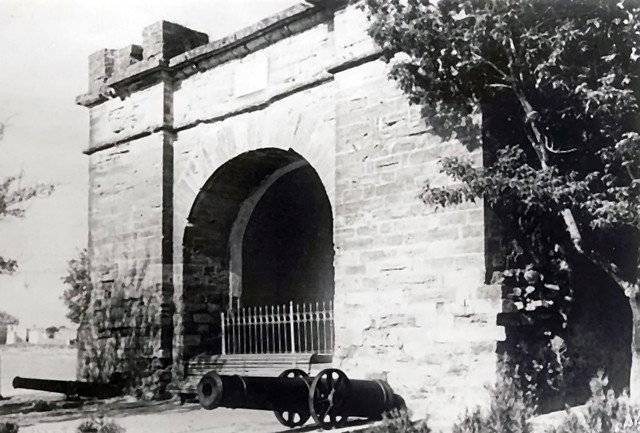
"Russian Gate" (the locals call them "Turkish") - the remains of a fortress, a monument of Ottoman architecture 18 century, as they looked in 1956 year.
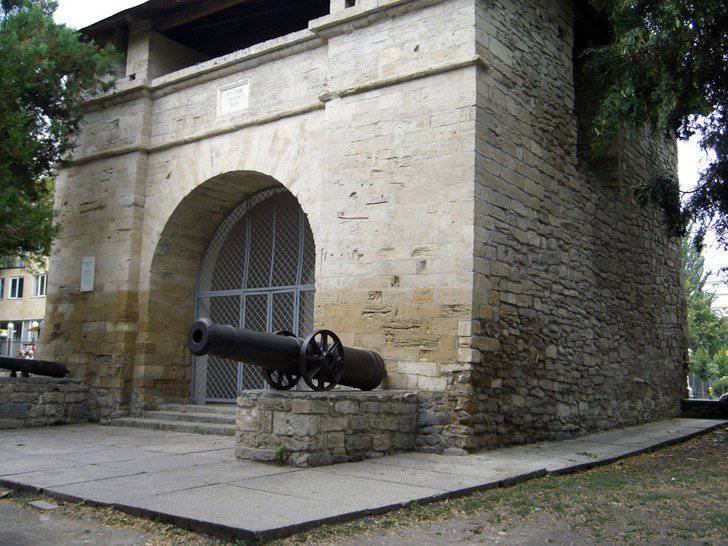
After reconstruction in 1996 year.
Results
- Turks and mountaineers lost only killed to 8 thousand people, a significant amount sank into the sea, 13,5 thousand were captured. Including the Turkish command and Sheikh Mansur. 130 banners were seized, all guns (some died in battle), thousands of firearms and knives. Whole Russian troops got - a large powder warehouse and garrison ammunition. The Russian army lost 3,7 thousand killed and wounded (according to other sources - 2,9 thousand).
- Sheikh Mansur was brought before the eyes of the Empress to Petersburg, and then to the honorary exile to the White Sea, where he died.
- Russian troops once again confirmed their highest level of combat training and morale, capturing a strong fortress - "Caucasian Ishmael", although there were fewer assailants in 4 times than defenders. Gudovich proved himself in this campaign as a brilliant commander. This strike will be a powerful shock for Porta after the fall of Ishmael.
- The fact that Gudovich made the right decision did not wait, confirmed the arrival of the Turkish fleet in two days. Gudovich set up an ambush, and the Russians were able to seize one ship, which was the first to approach the shore. The Turks, soon learned about the fall of the fortress on hundreds of corpses, these were people who drowned during the flight or were thrown into the sea by the dead (such a huge number of those killed could not be buried), panicked. Crews and airborne soldiers refused to go into battle - the commander wanted to bomb Anapa and possibly land a landing party. Turkish commanders were forced to lead ships into the open sea.
- Gudovich developed success - a separate detachment was sent from Anapa to the nearby Turkish fortress Sujuk-Kale (on the site of modern Novorossiysk). With his approach, the enemy burned down the fortifications and fled to the mountains or on ships to the sea, leaving 25 guns.
- Anapa in the Yassy world 1791 was returned to the Turks, but all the fortifications were destroyed, the population (up to 14 thousand people) was taken to the settlement in Tavria (Crimea region). Finally, Anapa became part of Russia under the Adrianople Peace Treaty of 1829.
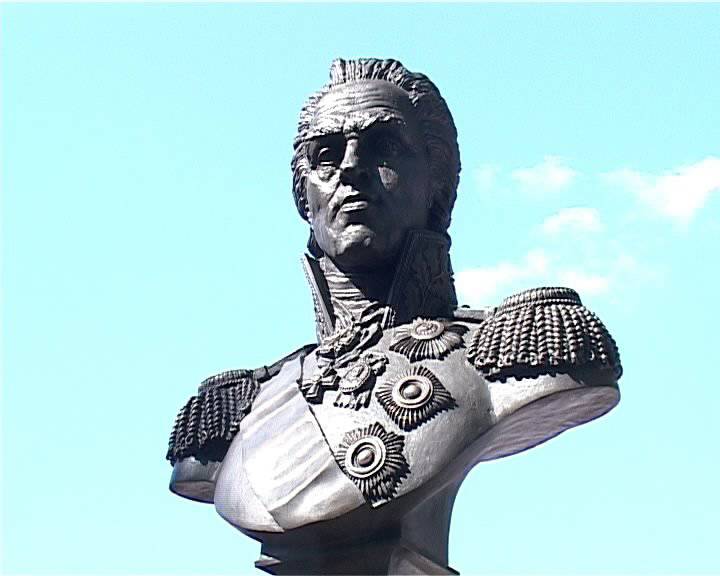
Monument to General Ivan Gudovich in Anapa.
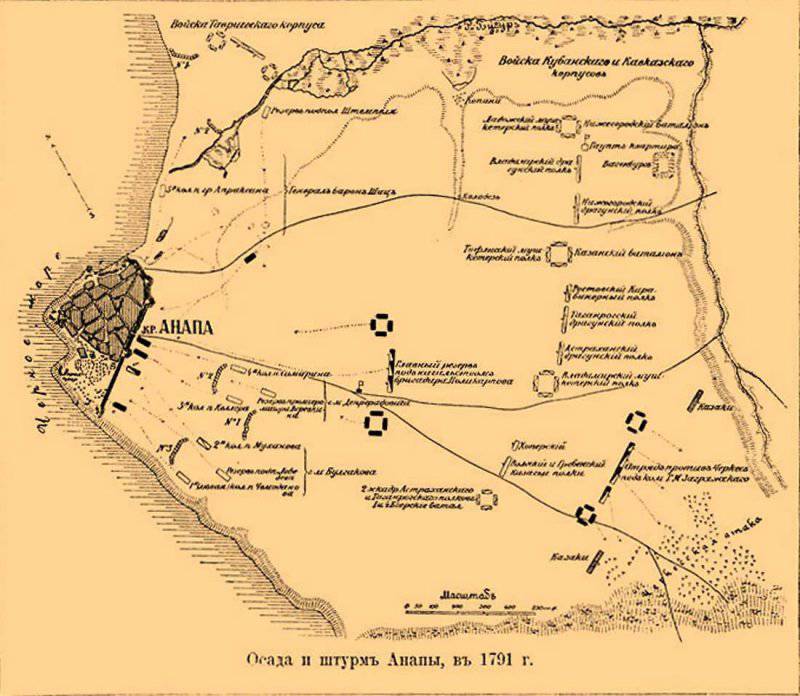
Information